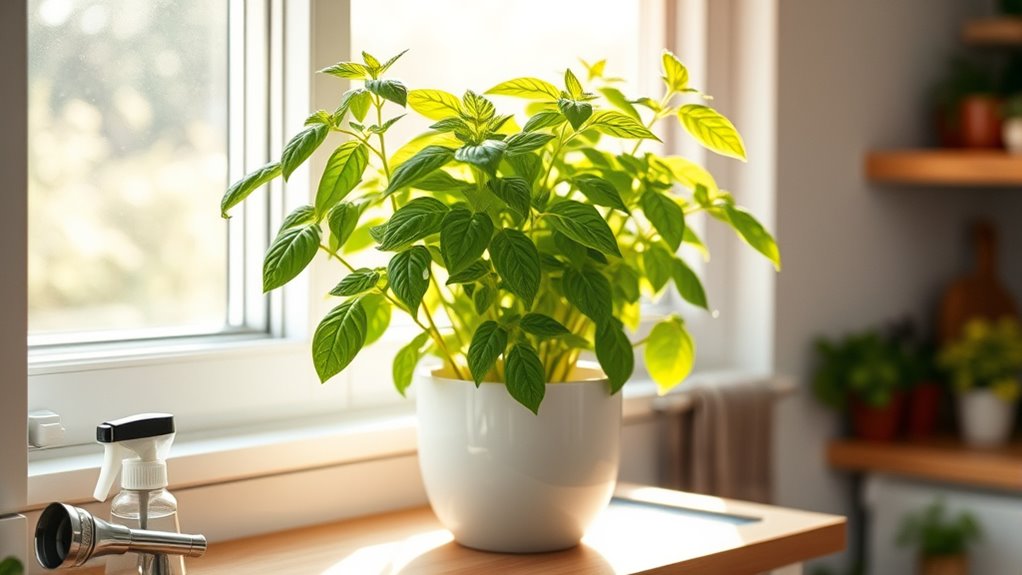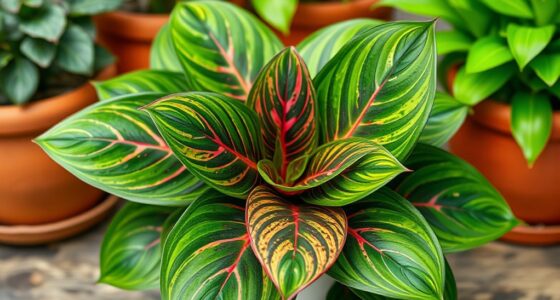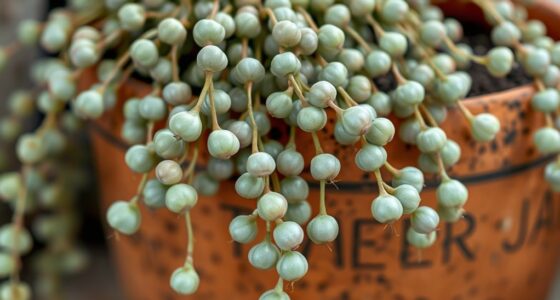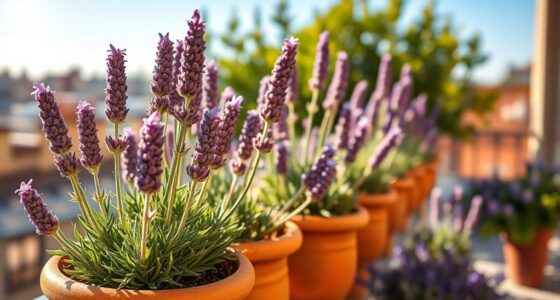To guarantee a year-round harvest of indoor basil, keep a consistent watering schedule, checking soil moisture often and avoiding overwatering. Use containers with drainage holes, and maintain even soil moisture. Regularly inspect leaves for pests and wipe them clean or treat with gentle soap if needed. Adjust watering and humidity based on seasonal changes and monitor for pests to keep your basil thriving. Keep exploring for more tips to maximize your basil’s health and flavor.
Key Takeaways
- Maintain consistent watering, allowing the top inch of soil to dry before rewatering, to promote healthy root growth.
- Use well-draining containers and monitor soil moisture regularly with a hygrometer.
- Inspect leaves frequently for pests like aphids and spider mites, and treat infestations promptly.
- Ensure good airflow and keep the indoor environment clean to prevent pest attraction and promote plant health.
- Adjust watering and care routines seasonally to sustain vigorous growth and year-round harvest.

Indoor basil is a versatile herb that can thrive beautifully with the right care. One of the most essential aspects of keeping your basil healthy is establishing a consistent watering schedule. Basil prefers evenly moist soil, so you should water it when the top inch feels dry to the touch. Avoid overwatering, as soggy soil can lead to root rot and other issues, but don’t let the soil dry out completely either. To make watering easier, consider using a container with drainage holes and a saucer to catch excess water. This way, excess moisture won’t sit around the roots, which helps prevent problems like fungal diseases. Regularly checking the soil’s moisture level allows you to adapt your watering routine as needed, especially during different seasons or indoor conditions where humidity levels can vary. Additionally, using a hygrometer can help monitor indoor humidity to optimize basil health.
Pest prevention is another essential part of indoor basil care. While basil is generally resilient, it can fall prey to pests like aphids, spider mites, or whiteflies. The best way to prevent infestations is to keep a close eye on your plant. Inspect the leaves regularly, especially the undersides, where pests often hide. If you notice any small bugs or sticky residue, take immediate action by wiping the leaves with a damp cloth or spraying a gentle insecticidal soap. Good airflow around your basil plant also discourages pests, so avoid overcrowding your indoor garden. Maintaining proper humidity and cleanliness can further reduce the risk of pests taking hold. If an infestation occurs, treat it promptly to prevent it from spreading, but always opt for organic or non-toxic methods suitable for indoor use. Pest prevention isn’t just about reacting to problems; it’s about creating an environment that discourages pests from settling in in the first place.
To keep your indoor basil thriving year-round, combine a consistent watering schedule with proactive pest prevention. Proper watering ensures your basil’s roots stay healthy, which supports robust growth and flavor. Meanwhile, vigilant pest control keeps pests from damaging your plant and spreading to your other indoor herbs. Both practices are straightforward but essential to maintaining a lush, flavorful basil plant indoors. By staying attentive and adjusting your routine as needed, you can enjoy fresh basil throughout the year without the hassle of dealing with pests or root issues. Your efforts will reward you with vibrant, aromatic leaves ready for culinary use whenever you desire. With patience and care, your indoor basil will flourish, providing a steady supply of fresh herb for all your cooking needs. Regularly inspecting your plant for filter signs and maintaining proper care routines will help ensure a healthy, productive basil.
Frequently Asked Questions
How Do I Prevent Basil From Flowering Indoors?
To prevent your basil from flowering indoors, you should regularly prune it using proper pruning techniques to remove flower buds as soon as they appear. Additionally, make lighting adjustments by providing 12-16 hours of bright, indirect light daily, which helps keep the plant in vegetative growth. Consistent pruning and ideal lighting encourage lush, flavorful leaves and prevent flowering, ensuring a continuous harvest throughout the year.
What Are the Best Companion Plants for Basil Indoors?
Pair pretty petunias and parsley for perfect companion planting in your indoor garden design. These plants promote basil’s growth, deterring pests and boosting flavors. Marigolds can also make marvelous mates, deterring pests and adding color. Choose companions that thrive in similar conditions, ensuring a healthy, harmonious indoor garden. With thoughtful pairing, you’ll cultivate a lush, lively landscape that supports your basil’s blossoming beauty and bumper harvest.
How Can I Increase Basil Leaf Growth Indoors?
To increase basil leaf growth indoors, you should optimize your watering schedule and light requirements. Water the plant when the top inch of soil feels dry, avoiding overwatering. Place your basil in a spot with at least 6 hours of direct sunlight daily or supplement with grow lights if natural light is limited. Consistent care guarantees healthy, abundant leaves and a thriving indoor basil garden.
What Pests Commonly Affect Indoor Basil?
You’ll often find aphids, spider mites, and whiteflies affecting indoor basil. To keep pests at bay, identify them early through pest identification and check your plants regularly. Use natural remedies like neem oil, insecticidal soap, or homemade garlic spray to treat infestations safely. Maintaining good airflow and avoiding overwatering also helps prevent pests, ensuring your basil stays healthy and productive year-round.
How Often Should I Rotate My Indoor Basil Plant?
You should rotate your indoor basil plant every 1 to 2 weeks to promote even growth and prevent it from leaning toward the light. Keep your lighting schedule consistent, providing 12 to 16 hours of light daily, and adjust watering frequency based on soil moisture—water when the top inch feels dry. Regular rotation guarantees your basil receives equal light exposure, encouraging healthy, lush leaves all year round.
Conclusion
By providing consistent light, maintaining proper watering, and ensuring good airflow, you create the ideal environment for your basil to thrive year-round. By caring for your basil with attention, patience, and love, you nurture not just a plant but a source of fresh flavor and beauty in your home. With dedication, your indoor basil will flourish, your culinary creations will shine, and your green space will become a lively, fragrant oasis—every day, every season.









